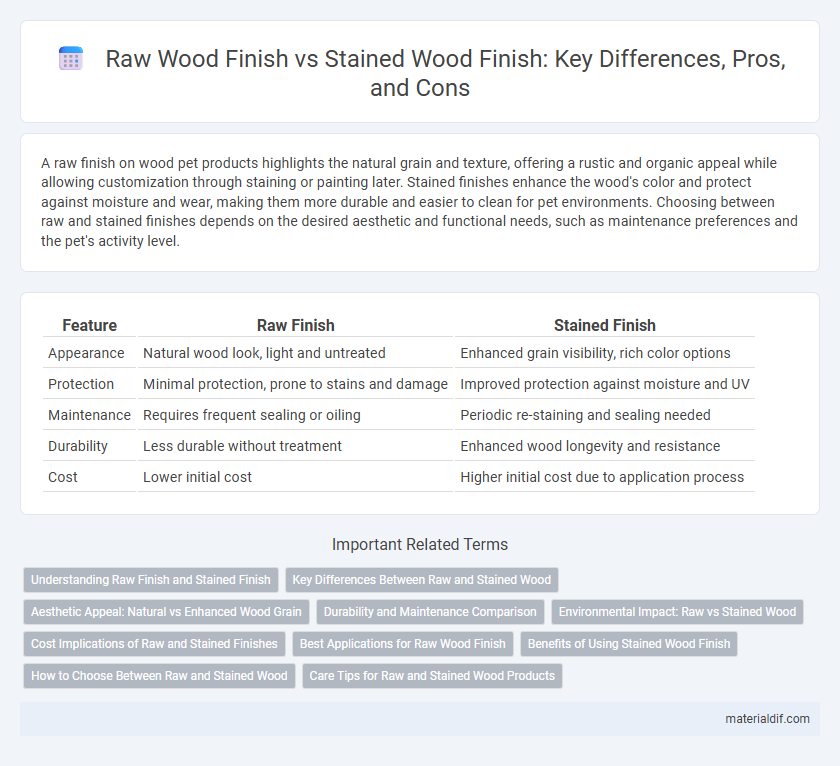A raw finish on wood pet products highlights the natural grain and texture, offering a rustic and organic appeal while allowing customization through staining or painting later. Stained finishes enhance the wood's color and protect against moisture and wear, making them more durable and easier to clean for pet environments. Choosing between raw and stained finishes depends on the desired aesthetic and functional needs, such as maintenance preferences and the pet's activity level.
Table of Comparison
| Feature | Raw Finish | Stained Finish |
|---|---|---|
| Appearance | Natural wood look, light and untreated | Enhanced grain visibility, rich color options |
| Protection | Minimal protection, prone to stains and damage | Improved protection against moisture and UV |
| Maintenance | Requires frequent sealing or oiling | Periodic re-staining and sealing needed |
| Durability | Less durable without treatment | Enhanced wood longevity and resistance |
| Cost | Lower initial cost | Higher initial cost due to application process |
Understanding Raw Finish and Stained Finish
Raw finish wood retains its natural texture and color, offering an organic and untreated appearance that highlights the wood grain and knots. Stained finish wood undergoes a process where pigments or dyes are applied to enhance or change the wood's color while providing some level of protection against moisture and UV damage. Understanding the differences helps in selecting the appropriate finish based on aesthetic preferences, maintenance requirements, and environmental exposure.
Key Differences Between Raw and Stained Wood
Raw wood retains its natural texture and color, offering a matte, unfinished appearance that highlights the grain and knots without alteration. Stained wood is treated with pigments or dyes that enhance its color, providing protection against moisture and UV damage while allowing customization of tone. Key differences include durability, maintenance needs, and aesthetic versatility, with raw wood requiring sealing for protection and stained wood offering immediate weather resistance and a wider range of color options.
Aesthetic Appeal: Natural vs Enhanced Wood Grain
Raw wood finish showcases the natural grain and texture, offering a rustic and authentic aesthetic that emphasizes the wood's innate beauty. Stained finish enhances the wood grain by adding color depth and contrast, creating richer and more vibrant tones that highlight the grain patterns. The choice between raw and stained finish depends on whether a natural, organic look or a polished, intensified wood appearance is desired for interior or furniture design.
Durability and Maintenance Comparison
Raw wood finish offers a natural look but requires frequent sealing and protection against moisture, UV rays, and wear to maintain durability. Stained finishes penetrate the wood fibers, enhancing resistance to weather and reducing the risk of cracking, fading, and warping over time. Maintenance for stained wood typically involves less frequent reapplication and easier cleaning, making it a practical choice for long-lasting wood surfaces exposed to outdoor elements.
Environmental Impact: Raw vs Stained Wood
Raw wood requires minimal processing, resulting in a lower carbon footprint compared to stained wood, which involves additional chemicals and energy-intensive treatments. Stained finishes often contain volatile organic compounds (VOCs) that contribute to air pollution and pose health risks during application and disposal. Choosing raw wood over stained options supports sustainability by reducing harmful emissions and promoting natural biodegradability.
Cost Implications of Raw and Stained Finishes
Raw wood finishes generally incur lower initial costs due to minimal processing and the absence of additional materials like stains or sealants. Stained finishes, while more expensive upfront, can enhance wood durability and reduce long-term maintenance expenses by protecting against moisture and UV damage. Choosing between raw and stained finishes requires balancing immediate budget constraints with potential future repair and upkeep costs.
Best Applications for Raw Wood Finish
Raw wood finish is ideal for furniture and interior elements where natural wood grain and texture are desired to enhance rustic or organic aesthetics. It suits environments with low moisture exposure, such as living rooms or bedrooms, where durability requirements are moderate and a natural look is prioritized. Raw finishes also allow for easy customization with oils or waxes, making them perfect for artisanal projects and handcrafted wooden items.
Benefits of Using Stained Wood Finish
Stained wood finish enhances the natural grain, adding depth and richness to the wood's appearance while providing protection against moisture, UV rays, and wear. It extends the lifespan of wooden surfaces by sealing pores, preventing warping and cracking commonly seen in raw wood. Staining allows customization in color and tone, improving aesthetic appeal and complementing various interior designs.
How to Choose Between Raw and Stained Wood
Choosing between raw and stained wood depends on the desired aesthetic, maintenance level, and application environment. Raw wood offers a natural, untreated appearance that highlights grain textures but requires sealing for protection against moisture and wear. Stained wood provides enhanced color options and durability, ideal for high-traffic areas or outdoor use, while allowing customization to match interior design schemes.
Care Tips for Raw and Stained Wood Products
Raw wood requires regular sealing or oiling to prevent moisture absorption and avoid warping or cracking, while stained wood benefits from periodic application of protective sealants to maintain color vibrancy and resist UV damage. Cleaning raw wood involves gentle dusting and avoiding harsh chemicals, whereas stained finishes need mild soap and water with soft cloths to preserve the stain integrity. Both finishes should be kept away from direct sunlight and extreme humidity to extend the lifespan and appearance of wood furniture or flooring.
Raw Finish vs Stained Finish Infographic

 materialdif.com
materialdif.com